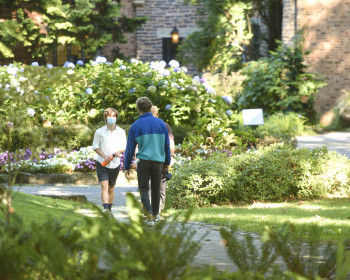Contingency Plan for Going Virtual: A Framework for Decision-Making
The Executive Council has developed a deliberate approach to events and thresholds that would make it advisable for us to change course significantly on in-person education and residential life. Factors include those internal to Lewis & Clark, as well as external community, medical, and political realities. This framework was developed with the assistance of a Short-Term Contingency Task Force and informed by consultation with epidemiologists and other experts.
We have been and will continue to regularly review a variety of quantitative and qualitative data to inform our decision-making. As we learn more about COVID-19 from public health officials and consultants, we realize that predetermined thresholds for action may yield ill-advised decisions with unintended consequences for health and safety. The approach outlined below is holistic and will allow us to best respond to changing circumstances and new information.
We will communicate more as circumstances and plans change. Please see our regularly updated Reporting and Notification page for the status of any COVID-19 cases on our campus.
Internal Factors: On-Campus Events
The key reason that would cause us to change course would be if COVID-19 on campus were to overwhelm, or threaten to overwhelm, our resources necessary to manage the virus (e.g., our ability to test, quarantine, contact-trace, etc.) and/or support students and/or teach classes in-person:
- One relevant factor for residential life is the number of isolation beds: We have 50 to 75 isolation and quarantine beds, which could house 5 to 7 percent of residential students. We could create more. However, if we were at or near capacity, and the trajectory were upward, we would likely need to change course in some way.
- We need to support students in isolation and quarantine, as well as support healthy students. If a significant portion of health services staff, area directors, RAs, etc., were ill or quarantined, we would likely need to change course.
- A rate of positive test results would be another indicator of the likelihood that our resources are in danger of being overwhelmed. We do not recommend any particular “magic number,” but this indicator and its trajectory should be monitored closely along with all other circumstances.
- If a significant portion of faculty or other front-line employees needed to provide on-campus instruction were ill or quarantined, we would likely need to change course.
- We might also change course if it appeared that non-compliant student behavior had increased the risk too substantially to continue.
External Factor: An increase in community transmission of COVID
As of September 1, the current COVID-19 case trajectory in the four-county region is favorable. A significant reversal of that trend would warrant reconsidering our approach.
External Factor: Government mandate
Federal, state, or local officials could order us to change our approach to teaching, either due to internal or external factors. State action is the most likely.
How We Might Respond
Depending upon the mix and severity of the factors noted above, we have a number of options for responding. These include:
- To again move fully (or almost fully) to remote instruction and teleworking and to depopulate the residence halls to the greatest degree possible. If students were to need to move out of the residence halls, we would likely have more time to plan and implement this process than was the case last spring, given increased knowledge about the virus and its trajectory. We intend to engage in consultation and would give the maximum amount of time possible, consistent with health and safety considerations.
- To move to remote instruction and teleworking and restrict movement and activities for a limited period of time in order to get better control of the situation. This could be institution-wide, or limited to one or two schools, depending on the circumstances.
- To stop short of full shutdown of in-person instruction. For instance:
-
- If we needed to de-densify the CAS campus and reduce residential occupancy, we could send certain classes of students (such as sophomores or juniors) home, after testing them for COVID. This would reduce the residential population, while preserving certain elements of the in-person experience for some students (e.g., first-year experiences for freshman, senior theses presentations, etc.), for those who chose to remain in-person.
- If we needed to de-densify the CAS campus but did not feel the need to reduce residential occupancy (or if it seems that the risk is primarily coming from students living off-campus), we could require nonresidential students to take all classes remotely.
- The law school and graduate school could move more fully toward remote education only.
Decision-Making
The Executive Council is closely monitoring what is happening on campus and in the community. We know that risk cannot be eliminated, only mitigated. We are consulting with epidemiologists and other experts and will make decisions based on the best available information and advice. We will share contingency plans in a timely fashion, and this framework may be revised as our understanding of COVID-19 and situational awareness changes.

